If you are planning a trip to Peru, you will most likely do it with Machu Picchu in mind. But if you do a little research, you will discover that Peru is much more than the world’s wonder. And as your travel date approaches, you’ll discover how excitement mixes with healthful anxiety. However, going through the Lima airport can be truly intimidating.
Especially if you don’t know the country’s official language, Spanish. Therefore, the Machu Travel Peru team wants to help you gather information about Lima’s Jorge Chávez International Airport. And how to arrive in Peru without complications.
Everything you need to know about the airport of Lima
- Overview
- Design
- Facilities
- Getting In and Out
- Flights arrivals
- Flights departures
- Forbidden things
- Narcotics
- International Connection
- National Connection
- Airport FAQs
Overview
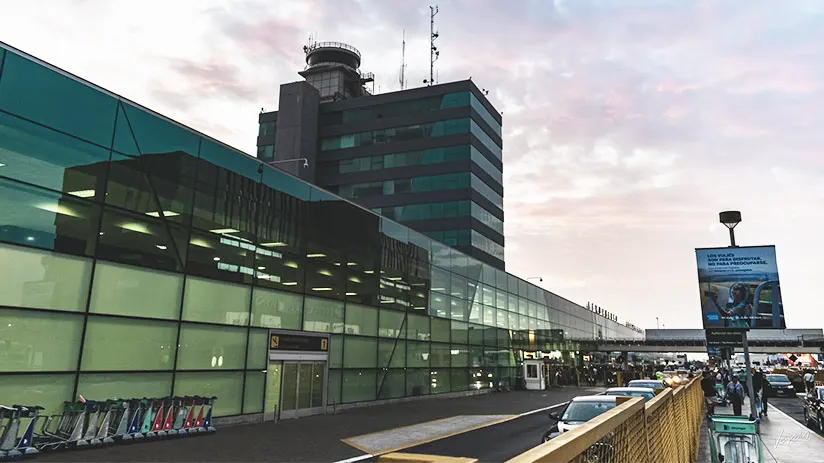
| Airport code IATA | LIM |
| Hours of attention | 24 hours a day |
| Address | Elmer Faucett Avenue, s/n, Callao 07031 |
| Elevation | 34 meters above sea level or 111 feet |
| Operating Domestic airlines | LATAM, Jet Smart, Sky Airlines, and Star Peru are the most important |
| Operating International airlines | Air Europa, Air France, Aero Mexico, Copa, Avianca, and Aerolineas Argentinas, among others |
Since its inauguration in 1960, the airport of Lima has been the most important in Peru. By receiving around 22 million international and national passengers annually. This flight terminal, with the LIM airport code, has the name of Jorge Chavez.
In 1910, he was the world’s first aviator and Peruvian to cross the Alps. This terminal is 12 km from Lima’s center. So, it is usually the landing destination of numerous international flights. By the way, Lima only has one airport, and it is this one.
If you plan to travel to another destination in Peru, then you will most likely make a stop here. This airport has a single terminal and can be a bit small compared to other renowned airports. However, this ranks as one of the busiest airports in South America. And if you are looking to go from Lima to Machu Picchu, you will surely begin your journey from this beautiful airport!
1. Brief history
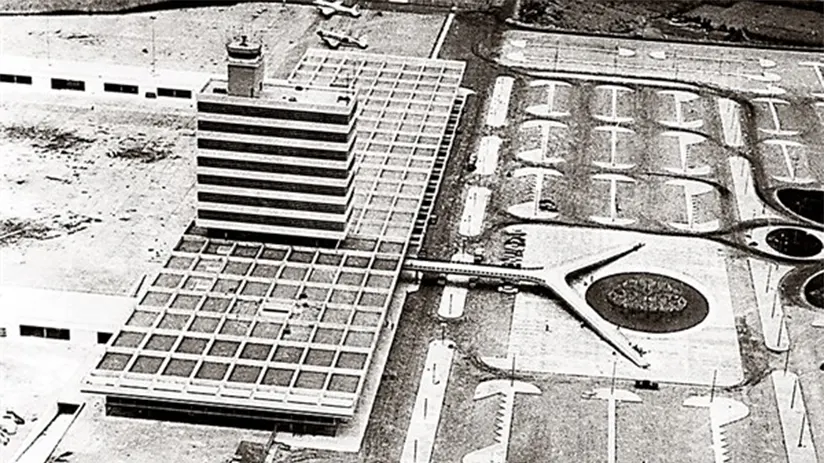
The Inauguration of the Peruvian capital airport was in 1960 to replace the ancient airport ” Limatambo.” The buildings and houses of the recent San Isidro district (Lima Center) were trapping and enclosing the Limatambo airport.
Therefore, the new airport had to be outside of Lima. The architects in charge of the project chose the constitutional province of Callao as the perfect place for the new airport. As it is 12 kilometers west of Lima and close to the beaches of the Pacific Ocean.
Nowadays, Jorge Chavez has more than 90,300 square meters in its unique terminal. It has a platform of 729,600 square meters, including a runway. In this form, Jorge Chavez is ready to face the new era with new challenges.
Furthermore, the airport has 60 aircraft parking spaces. This is not to mention the area with 44 departure lounges and some 19 loading bridges. In addition to 142 passenger check-in counters. In this form, the airport serves as a hub for some 24 airlines.
There are also about 50 international destinations along with 18 national destinations. In 2019, numerous air carriers and freight firms began utilizing Jorge Chavez as South America’s primary center for transporting merchandise. In this sense, Jorge Chavez Airport saw an increase in shipments. Consequently, it has also become a key player in the South American shipping industry.
2. Lima airport location
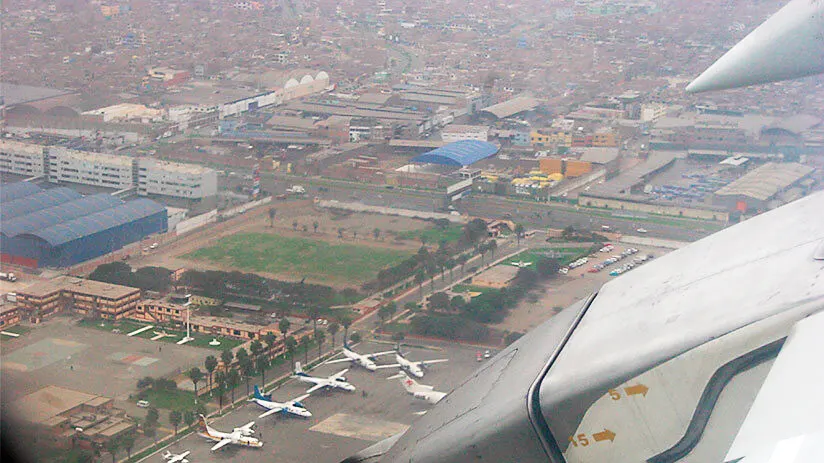
Believe it or not, this airport is not in Lima but on the city’s outskirts, in Callao’s constitutional province. And how far is the terminal from the city center? About 7.5 miles (12 kilometers) west of downtown Lima.
In other words, it is approximately 10.5 miles or 17 kilometers north of Miraflores. By the way, Miraflores hosts most of the hotels and restaurants in Lima. Elmer Faucett Avenue is the main highway from which to enter the airport.
This avenue usually has traffic between 11 a.m. and 8 p.m. every day, so take precautions. Our recommendation is to add 1 hour more to the usual time to show up at the airport.
3. Future expansion
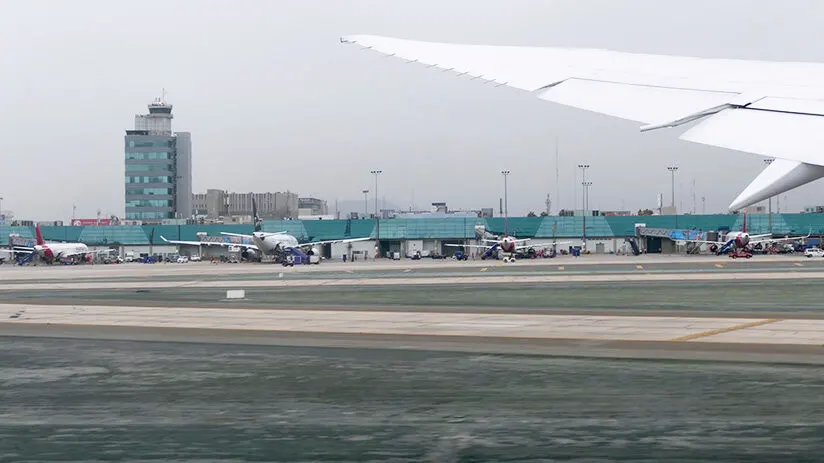
If you want to know more, the state of Peru is about to complete an actual expansion and improvement project for the airport. This project is tripling the size of the current airport. This includes a second runway, a second terminal, and a new control tower.
Finally, the Peruvian government plans to connect the airport and the new airport city. To that end, it will build an improved road network system and mass transportation between both terminals. The government will finish these works in 2025.
Design
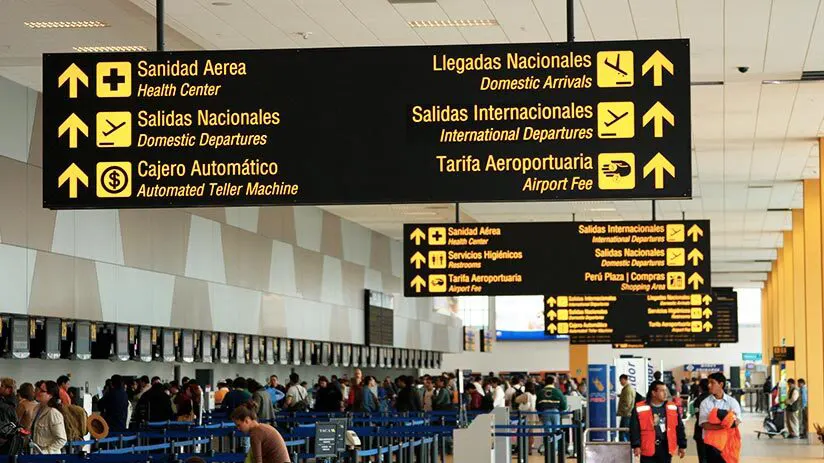
Jorge Chavez Airport also has a single terminal that serves both international and domestic flights. Despite this, the terminal is a small but well-organized airport. The architects designed it for passengers’ comfort.
All the posters are in English and Spanish, and a large part of the staff is bilingual. So you will not have great trouble locating yourself. Also, Jorge Chavez Airport itself has maps to help you find yourself.
These will make your journey through the site much easier, and you will be able to find the different locations quickly. Also, if you are wondering about the best time to visit Lima, you have to know that any moment is good.
1. The first floor of Terminal
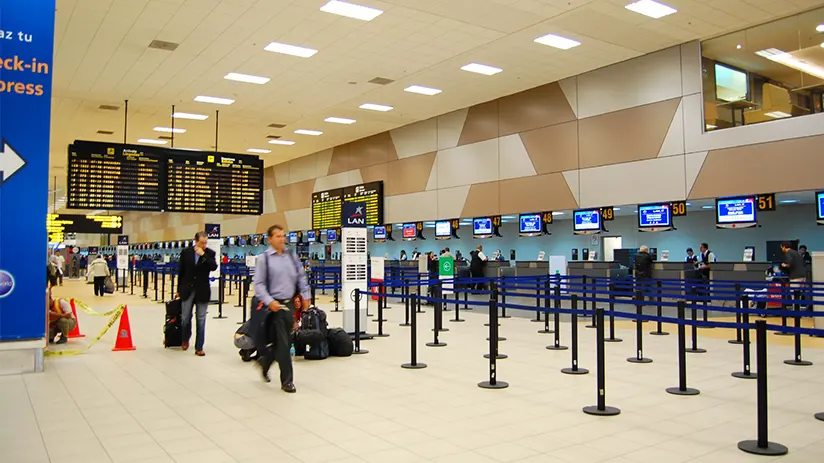
a. Airlines counters
On the first floor, there are the counters of many air companies, where the billing is done.
b. National and International arrivals
The national arrivals are on the right, while the international ones are on the left. The gate arrivals are from 1 to 7 and 30 to 39, respectively.
c. Tourist information
A tourist information counter is on one side of the international arrival zone. Here, you will find information about your flight, boarding area, and more. The personnel are very friendly and speak English.
d. Storage lockers
These are closed cabins of 18 x 24 x 75 inches. You can hire one and guard your luggage there. The cost is $4 per hour and $17 per day. Of course, the longer you leave your suitcase, the cheaper the cost.
e. Luggage storage
Airport personnel guard your luggage in large storage areas. The airport offers this service, and the cost is usually cheaper: $2 an hour and $13 a day. In the same way, the longer you leave your suitcase, the cheaper the cost. It is next to Storage lockers.
f. Shoe-shine
There are two shoe-shine counters, and both are next to international and national arrival areas.
g. Health center
A health center is outside the national arrival zone.
h. Luggage wrapping service
This is just in front of the airline’s counter area. The cost of luggage wrapping is $9 per bag.
i. Police station
This is on the far left of the first level of the terminal. The police carry out routine inspections on suitcases and clothing with their dogs and hounds.
2. The second Floor of Terminal
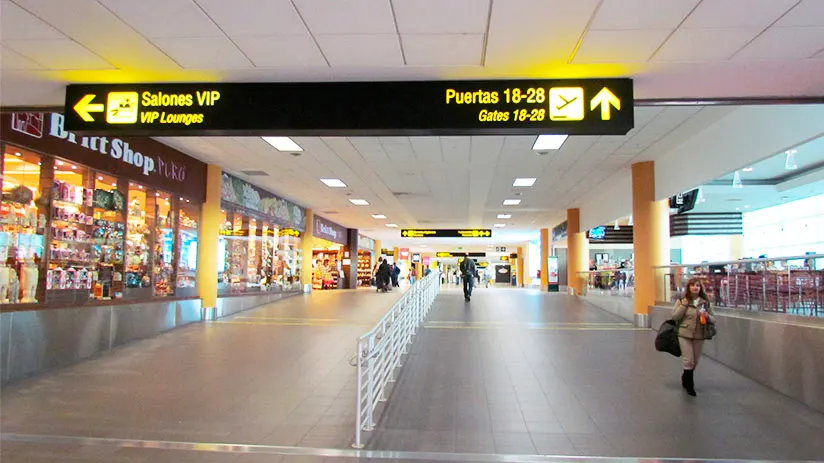
a. Food court
This zone is on the far right of the terminal. It features McDonald’s, Burger Kings, Pizza Hut, Papa John’s, Starbucks, Subway, and Dunkin’ Donuts. Without mentioning Peruvian franchises like Bembos and China Wok, among others. The food court is open every day, 24 hours a week.
b. Coolbox
It is an electronic store where passengers can buy various electronic items. These include rechargeable batteries, headphones, cell phone cases, and cell phone batteries.
c. Spa center
This is on one side of the commercial zone. It offers massage, hair removal, nail and skincare treatments, and comfortable seats for rest. You can also take a shower there. The cost of renting this shower is $10.
d. Choco Shop
The Cacao Republic Chocolate shop has a large store in this Airport. There, passengers can buy original and general types of chocolates, like rose petals. Or local supplies, like Maras salt, among others.
e. Book Store
There is a bookstore on just one side of the commercial area. There, you can buy fiction and non-fiction books, novels, magazines, CDs, DVDs, and music.
f. Souvenirs shops
On the second floor, you will find the Britt Shop. They sell a variety of souvenirs like local t-shirts, Inca souvenirs, travel books, and gourmet products.
Britt Shop has two stands, one just in the commercial zone and the other passing the security and control post. Besides this store, the passenger can find Alpaca and Vicuña clothes and souvenirs like Kuna and Sol Alpaca.
These are luxury stores, and their products are very expensive. If you can buy Vicuna and Alpaca fabrics while in Peru, it’s better than purchasing them in these stores.
g. Telephone line posts
Two Peruvian telephone lines are near the security and control post. They offer mobile chips with internet data and cell phone rentals for making national and international calls.
h. Interbank Money Exchange counter
It is on the left side of the security checkpoint. A well-known Peruvian bank operates it. However, the exchange rate is expensive there.
i. Boarding gates
You will also find the security control that checks each passenger. Once you have passed through the control, you will be able to see both the international (Left) and domestic (Right) departure gates. These gates are from 6-9 and 12-26.
j. Starbucks
The most famous coffee chain in the United States is also present at the Jorg Chavez airport. It has free Wi-Fi for consumers.
k. Airlines administrative offices
On the second floor are the airlines’ offices with large stores.
l. SERPOST
The government postal service runs the post office. SERPOST is between the airline and airport administrative offices. The service works at the national and international levels by sending letters, postcards, and small packages.
m. Pharmacy
A drugstore is next to the Post office and just over the health center. This is so complete and is open 24 hours a day, every week.
n. Chapel
For Catholic people, the airport terminal has a little chapel where they can meditate and pray.
A. Airside international departure lounge

Once passing the security and control post, there is no turning back. But don’t worry, inside you will find:
a. Spacious seats
Each departure lounge has comfortable seats without armrests, so you can stretch out and have a good time. They are available in both national and international departure lounges.
b. Dutty Free
The duty-free shops are only in the international departure lounge. These offer high-end products free of tax and duty. We can mention souvenirs, chocolates, perfumes, clothing, liquors, cosmetics, and cigarettes, among others. Even electronic items such as batteries and chargers for cell phones, laptops, wireless speakers, headphones, and much more.
c. Food stands
Many food stands are between the control post and departure lounges. These offer food, coffee, and hamburgers, among others. However, you will find more variety in the food court and the cheapest prices, too.
d. High-end souvenir stores
Stores like Kuna and Illaria are the most well-known luxury stores. These are close to international departure lounges. Kuna is a manufacturer of high-quality clothing with baby alpaca, alpaca, and vicuña fabrics. And, Illaria is a manufacturer of jewelry made from Peruvian gold and silver.
e. VIP Club Lounge and Sumaq VIP Lounge
Both are VIP salons located in the international departure lounges. There, you can rest in comfortable and overstuffed armchairs and a buffet of national dishes. Without mentioning a business center, Wi-Fi, a bar, a TV, and showers. The right of admission has a cost of $60 to $70, and you can stay there for up to 4 hours.
B. Airside national departure lounge
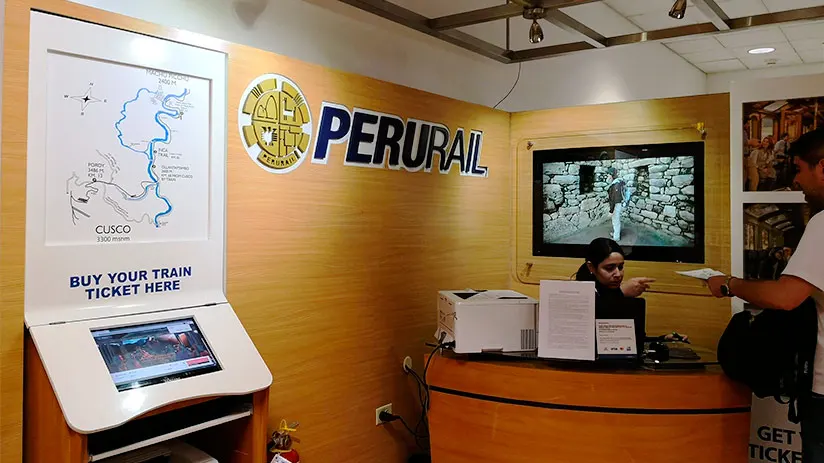
When traveling domestically, you will have fewer service and stand options after passing through the security checkpoint.
a. Peru Rail stand
Peru Rail is the oldest railway company in Peru. It offers first-class tourist trains to Machu Picchu, such as the Vistadome, luxurious Hiram Bingham, and Andean Explorer. Here you can find one of their stands with staff willing to help you with your requirements.
b. Caral VIP Salon
This is the only VIP salon destined for National passengers. Caral is in the national departure lounges and offers a bar, TV, Wi-Fi, and a national dishes buffet. It also has overstuffed armchairs, a business center, and showers. The right-of-admission price ranges from $60 and up.
3. Parking zone
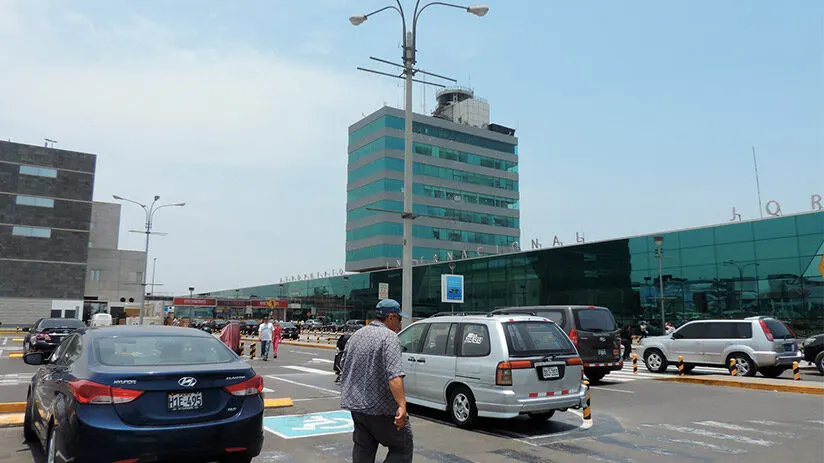
The Lima airport offers a spacious parking zone just in front of the terminal. The rates depend on the size of the car and the time. The parking for a short time is exclusive for cars (2.20 meters large)
- 45 minutes: 5.20 S/. Soles
- 46 – 60 minutes: 7.00 S/. Soles
- More 61 minutes: 7.00 S/. Soles per hour
- Parking for every 24 hours: 45 S/. Soles
Special machines between the parking zone and the terminal receive the payment for parking. These accept cash (Dollars or local coins) and VISA, MasterCard, American Express, and Diners Club credit cards.
Facilities
A. Wi-Fi and charge zones
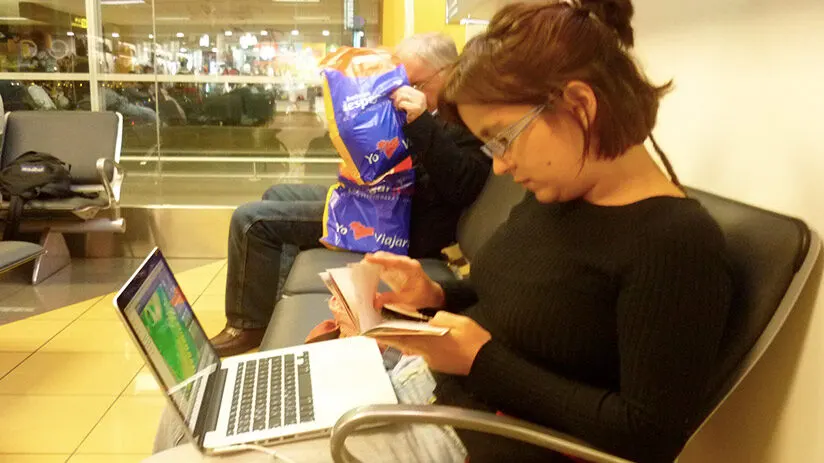
Nowadays, Jorge Chavez International Airport has free Wi-Fi in most of its areas. However, the signal is not strong—just enough to browse the web, social networks, and WhatsApp.
So, if you want to make a video call or watch a movie, you will have to occupy your time with something else. For the first connection, you will have 1 hour of free Wi-Fi (Name of signal: Free Airport Lima).
After that, you will wait approx 15 minutes to get another hour of free Wi-Fi. Finally, you will have to pay the Premium Services (Premium Airport Lima) to get a stronger signal. But it is still a disappointment.
- $5 Dollars for 2 hours
- $10 Dollars for 10 hours
- $12 Dollars for 30 days
The pop-up accepts all credit cards
B. Lounge areas
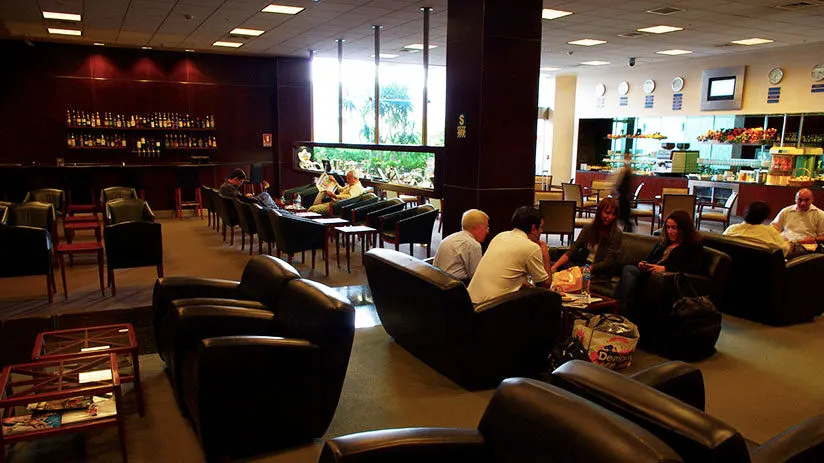
Due to the great tourist flow, Lima’s airport has three lounge bars. There, the passengers can rest and have a cup of coffee. Or kill time while the personnel finish to condition the flight. The premium clients of several credit cards have complete access to these establishments.
- Hanaq VIP Lounge: In the Lounge bar, passengers can enjoy Wi-Fi, a buffet, non-alcoholic drinks, and coffee. Without mentioning a business center, amenities, a TV, a children’s area, restrooms, and even showers. They are open all days of the week. The lounge is in the International flight down area, just in front of gate 17, in a corridor.
- Sumaq VIP Lounge: It is before the Hanaq VIP lounge (to one side of it). The lounge has benefits similar to the Hanaq VIP lounge and a similar attention schedule.
- El Salon by New Rest VIP Lounge: It has benefits similar to those of the previous two. With the difference that it is in the National flight-down area, just in front of gate 13. It is open from 1:30 a.m. until 11:00 p.m.
- Club VIP Lounge: Domestic hall, second level. Services: Showers, newspapers, magazines, printers, photocopiers. Hours: 24/7.
C. Luggage Zone
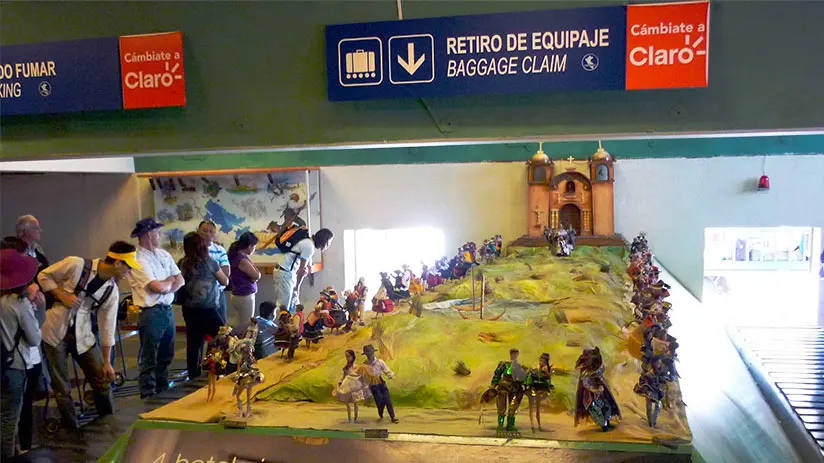
The Jorge Chavez airport has a special luggage storage service in public areas. Outside of the international flight arrival zone. The prices of the service per luggage are:
- Per hour: $2 or S/ 3.80 Soles
- Per day: $13 or S/ 50 Soles
- Prices can go down if you use the service for a longer number of days or have many items to guard
Take note that they only accept cash (American dollars or Local coin Soles)
D. ATM Machines
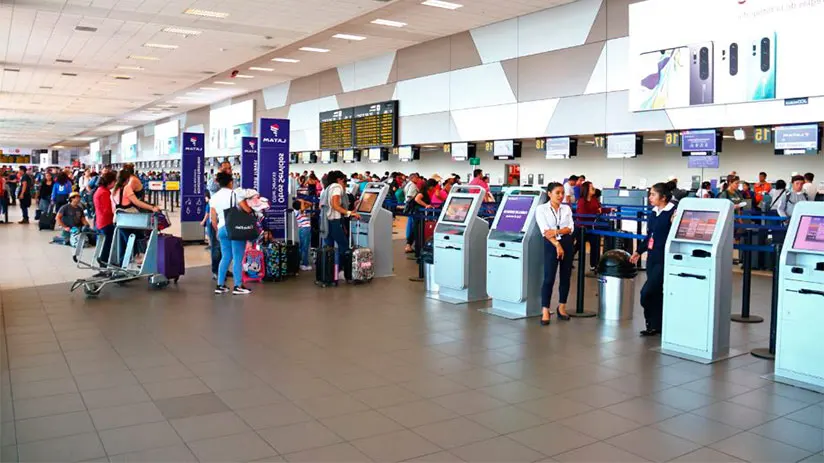
ATMs are throughout the airport. Getting cash from here is more expensive than from an ATM outside the airport terminal or in the city itself. So we suggest you do it only when necessary.
E. Money exchange counters
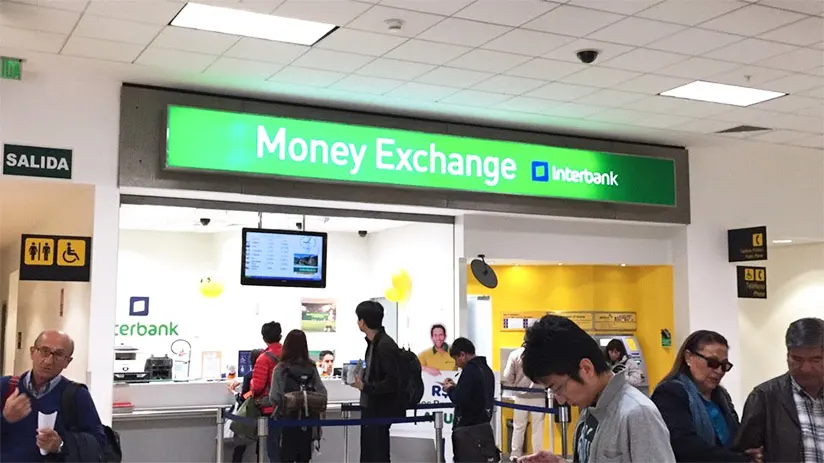
Fortunately, you can also exchange your dollars or currency of choice for the official currency of the country. Interbank or Word Xchange stores are available the vast majority of the day. Although the exchange rates can be somewhat high compared to other places in the city.
Getting IN and OUT
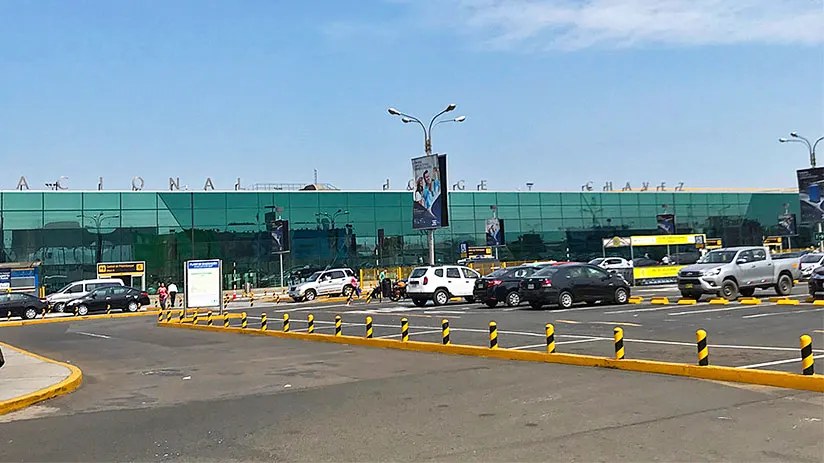
As you can see, the Peruvian capital airport is on the outskirts of the city. It takes a long time to get there from most hotels situated in Lima’s middle-class neighborhoods. Among these, we can mention La Molina, San Isidro, Surco, and Miraflores neighborhoods.
Therefore, it will be necessary to get a Lima travel guide. Or know the principal transportation ways to get in and out of the city.
A. From the airport to Lima city
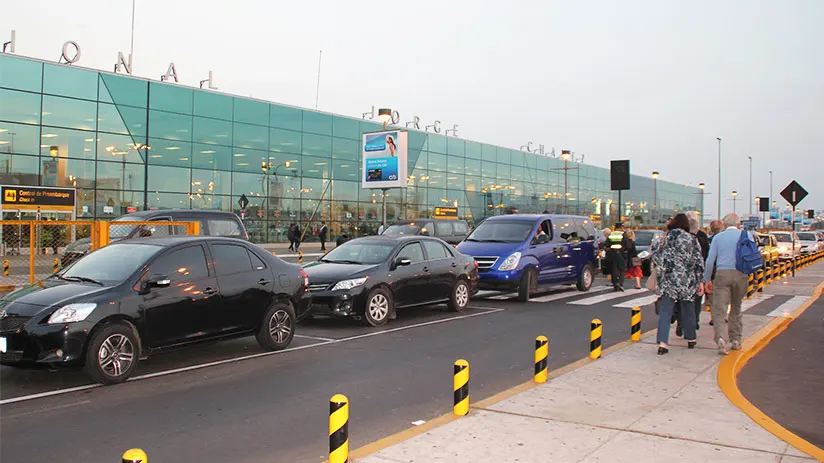
Happily, upon arrival, you can find a variety of transportation options to get to Lima Center. These can also take you to the main middle-class neighborhoods that host the majority of hotels.
1. Airport Express Lima Bus
It is the airport’s official bus company and offers more than 50 scheduled transfers per day. The buses go from the airport to the most well-known tourist attractions in Lima, Miraflores, and San Isidro.
The company has 12 bus stop points. The cost of the ticket is $8 for one way to Miraflores and $6 for San Isidro. Its terminal is in the same parking area, opposite the passenger terminal. The buses are modern, with large windows, comfortable seats, air conditioning, Wi-Fi, and unlimited luggage storage.
One of its counters is in the International arrival zone, and the other is in the baggage claim of domestic flights. You can also buy bus tickets directly online at Airport Express Lima. Best of all, there is no limit on luggage transport!
2. Taxi
- Taxi App: Besides taking an authorized taxi, this is our recommended form for moving to Lima. Fortunately, there are many taxi app companies to use, including Uber, Cabify, InDriver, and Didi.
- Authorized taxi: Today, there are counters of 3 formal taxi companies in the baggage claim area. Taxi Green, Taxi 365, and Taxi Directo. These companies are serious and provide clear information about taxi drivers. They also provide the service cost and the currency payment in Soles or Dollars. The service usually begins at $20 or more. Without mentioning the approximate time of arrival at your destination. The good thing is that the payment is in advance, and they always deliver a bill of sale. The drivers and the taxis are well-signposted.
- Registered taxis: Outside the airport terminal, you’ll find taxis authorized by Callao and Lima municipalities in the parking zone. Usually, these have a checkerboard of yellow and black colors on the sides of the vehicle. These will take you to the central Lima districts, Miraflores, Surco, San Isidro, and La Molina. Remember to quote and bargain the travel price and the currency type of the payment (Dollars or Soles) before hiring them. It is because the taximeter doesn’t exist in Peru. Usually, the price is lower than taxi apps. It is around S/60 to Miraflores, San Isidro, La Molina, or Surco district.
- Non-registered taxi: The taxi profession is free in Peru. These kinds of taxis stay outside the airport (on Elmer Faucett Avenue). No government institution or company regulates them, and they usually resemble private cars without any taxi signs. In the same way, you’ll have to agree on a price, the currency of payment. And the responsibility of paying the airport parking tax (you or the driver) before taking one of these taxis. However, we don’t recommend taking these taxis for any reason.
3. Public Transportation
Lima represents chaotic traffic and a precarious transport system. The Peruvian capital has no subway. But it does have different minivans and vans that Peruvians call “Combis.”
These transportations have small and tiny seats, without luggage space, dirty, most of them are old and are always full of people. Usually, the passage costs 2 or 3 Soles from the airport to different districts of the Capital.
Depending on where your hotel is, you will have to make several transfers to get to the hotel.
Lima is a big city, and a single Combi is not enough to reach your destination. If you wish to avoid long trips in a “Combi.” Which can mean a time-consuming wait to take another Combi. Or lugging your baggage around during the trip.
And, dodging thefts and pickpockets. We don’t recommend this kind of service.
5. Private Shuttle Service
If you hire tours through a travel agency, they include private transportation from/to the airport. In other words, it is a completely private car for you. On the other hand, if you come without any tour package, you can hire a private shuttle service.
From the counter located on one side of the taxi counters at the baggage claim area, you can hire them. The company name is Peruvian Shuttle and Lima Transfer Co. The costs can go from $120 and up.
The units range from sedan cars to Mercedez Benz sprinters or minibusses. If you are coming with many people, a taxi is not convenient. But private shuttle transportation like a minibus or van is available. Better for a group.
All will depend on you.
6. Lima car rental
Hertz, Budget Car Rent Peru, Avis, Dollar Rent a Car, Alamo, and the local ANC groups have counters in the airport. These are on the first floor (north side) of the airport terminal.
Just one side of the Authorized taxi counters. They are open 24 hours a day, and you can hire a car directly from there. Usually, the base rate starts at $400 per week for a little car.
You’ll have to increase the warranty cost above this amount, without mentioning the advance payment for damages. The company will refund the two last payments according to the state of the car.
Take note that Lima doesn’t have an underground or integrated transportation system. The city only has one electric train that passes through only a few districts and bus lines that barely work. For this reason, almost the vast majority have a car in Lima.
This generates infernal traffic in the capital. If you want to rent a car and be part of this traffic, think twice. Without mentioning the poor condition of Peruvian tracks and railways.
B. From Lima city to the airport
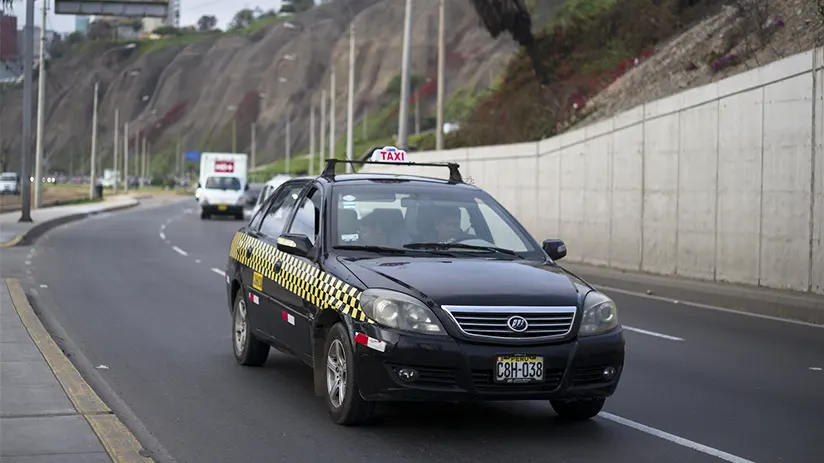
Despite the traffic in Lima and the distance, there are very trustworthy transportation services to get to the airport. Of course, you will have to take note of your flight. If this is an international flight, you will have to get to Jorge Chavez airport 3 hours before departure.
In this case, you will have to take your transportation 1 hour earlier than these 3 hours. In the case of domestic flights, getting to the airport 2 hours before the departure is recommendable.
Consequently, taking your transportation from your hotel 1 hour earlier will be recommendable to avoid drawbacks.
1. Taxi
- Taxi App: This is the most recommendable option. Happily in Lima, there are many taxi apps services like Didi, InDriver, Cabify, and Uber. For the security of the passenger, the app company has a large database of all its drivers. Besides, you have the chance to learn the cost of service before taking the taxi. Remember that Peruvian taxis don’t have a taximeter. The taxi services can cost from $20 and up. The trip time to the airport can take 30 – 40 minutes.
- Registered Taxi: Remember, these are taxis registered in Lima’s municipality. Therefore, these have a yellow and black checkerboard on both sides of the car. You can take them from the same street, but we will always recommend using the taxi app. The cost can go from S/60 and up. But remember that these don’t have a taximeter. So, you will have to bargain the price, the coin of payment, and the cost of airport parking before taking their services. The trip time to the airport can take 30 – 40 minutes.
2. Airport Express Lima
If your hotel is in San Isidro or Miraflores, you can go to one of the 12 bus stops of Airport Express Lima. There, you can take a bus to go directly to the Airport. You can check the location and route schedule of these bus stations.
Air conditioning, comfortable seats, Wi-Fi, and unlimited luggage storage will accompany you to the same airport. The route cost one way to the airport is $6. After the taxi app service, we highly recommend this type of transportation. The trip time to the airport can take 60 minutes.
3. Public transportation
Lima offers one of the worst public transportation systems in the world. Many routes of “Combis”, traffic, and chaotic streets. Without mention the state of cars, dirty, with old seats, no space for suitcases and overcrowded.
Besides, you will have to take more than one Combi to make connections to the other and arrive finally at the airport. The cost per person in one route goes from 2 to 3 Soles. Definitely, we don’t recommend this type of transportation in any case.
Additional note, the traffic in a city like Lima that doesn’t have a metro is unbearable. This usually increases in time ranges from 07:30 to 10:30 am and from 16:30 to 21:30 pm every day. Therefore, arriving at Lima airport can take more than 02 hours!
Also, keep in mind that the combis will leave you outside the airport. So, you will have to cross Elmer Faucett Avenue and its terrific traffic. This can be quite an odyssey.
4. Private Shuttle Service
In the Hotel reception, you can hire cars from sedans to large Mercedes Benz Sprinters. Or from your travel agency. All will depend on what kind of service you have in Peru.
Of course, it is the most expensive type of transportation. Usually, the cost goes from $80 and up. If you have many people on board, a group of friends, family, and cousins, this type of service can be for you.
Flight arrivals
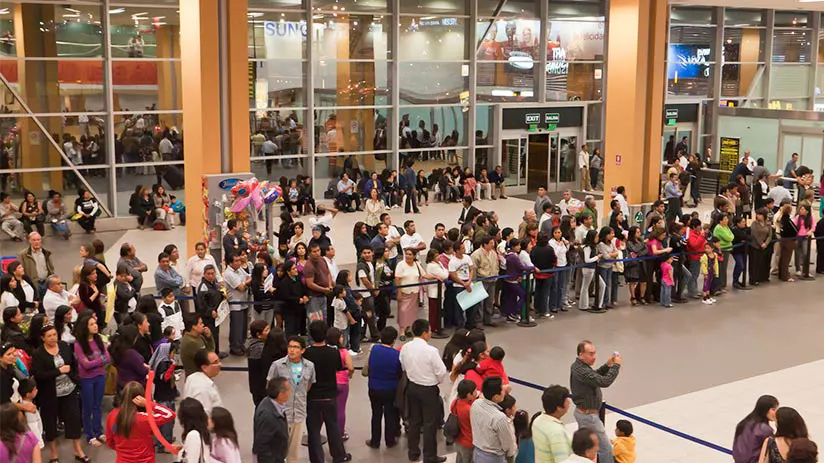
Usually, it takes around 1 hour to get out of Jorge Chavez Airport. So, from when the plane lands until you find your transfer, it may take a while. Despite this, if many flights land at the same time, delays can occur.
There aren’t enough immigration staff and baggage delays, so it could take 2 hours to get through all the checkpoints. So from the plane to your transfer, it may take a little more than an hour depending on the flight. And what happens during this time?
1. Aduana and electronic TAM
About 55-min before your flight lands at Lima, the flight attendants will give you a customs declaration formulation. There, you will have to declare the articles and quantity of cash that you are carrying. The international flight laws forbidden Fresh vegetables, fruits or meats on board.
The law also forbidding certain medications, weapons, animals, and large amounts of cash, among others. Please be honest when declaring, as you may be subject to a bag check at the checkpoint. The Andean Migration Card is a kind of free Visa to enter Peru. There, you’ll register your date of the enter and departure from Cusco and personal data.
2. Migration control
There you will have to show your passport and flight ticket. Remember to have an updated passport and check if your country of precedent requires a visa to Peru. What is the reason for your visit to Peru?
For how many days will she stay in the country? When is your return date? What places will you visit? The immigration official can ask these questions.
If you are citizen of Andean community, you will have a special counter of migration control. Ecuador, Peru, Bolivia, and Venezuela belong to the Andean community. The maximum period to stay in Peru is 183 days.
3. Luggage pick-up
Passing migration control, there are luggage carrier sleeves. Please check the screens above the baggage claim area. Make sure to find your flight number and destination. Wait for your luggage once you have confirmed this information.
4. Customs control
Once you have your luggage and meters in front, Customs personnel will hand out declaration cards. In this card, you’ll register all your belongings. Remember, the law forbids carrying fresh vegetables, fruits, or meats.
In addition, carrying weapons, drugs, and medicines (whether for yourself, for others, or for commercial use) is a crime. Without mentioning animals, pesticides, weapons, commercial merchandise, inter alia. Moreover, carrying more than $10,000 in cash is a crime, too. On the other hand, if you don’t have any of these things, you can pass freely.
However, indistinctly, the Aduana officers can open your luggage to contrast your declaration of the card with the truth.
5. Transfer service
When you get to the first floor of the airport, you will see different transportation options outside the terminal. These options can take you to your hotel, Airbnb, or hostel. You can check our section on transportation lines to know what transportation types are.
Flight departures
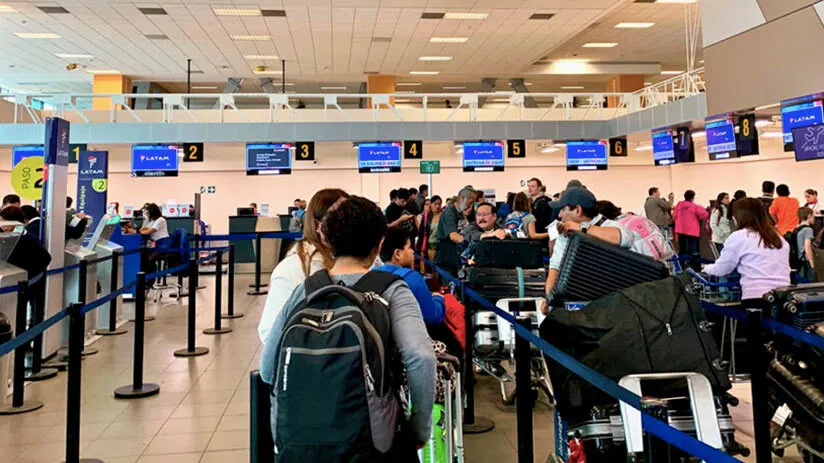
Whether your flight departs inside Peru or outside, you will have to leave the hotel many hours in advance. We recommend arriving at the airport 3 hours before the international flight departure. In the same way, we suggest getting to the airport 2 hours before domestic flight departure.
However, you will have to add 2 hours more to these times, but Why? The traffic all day in Lima is the answer. If you get stuck in Lima Center or on Elmer Faucett Avenue, it won’t be surprising. Therefore, take precautions and get early to airport of Lima.
1. Luggage register counter
At the entrance to Jorge Chavez airport, is the first point to stay. You will have to register your luggage at the airline’s counter located on the first floor of the terminal. Each airline company has its own luggage and weight policies.
2. Security point control
After registering your luggage, you will have to go to the second floor. There, you’ll enter through the main departure flight gate to security control. Where you will have to take off your metal objects, jackets, belts, and keychains, among others, and go through the metal detector. After, you can go directly to the Customs control point.
3. Customs control
The passenger who has a domestic flight can go by the left directly to their departure lounges. Instead, the passengers who have international flights will have to go, by the right side, to Customs control.
They have to carry their passports updated and flight tickets at hand. The customs official will review the documents. In general, they will ask a simple question before stamping a seal of visit registration in your passport.
Finally, they will give them back the documents. If the tourist exceeds the allowed limit of permanence of 183 days, they will have to pay a penalty in cash. This is $1.30 per extra day in Peru.
4. Departure Lounge
The mini journey will be over. There you will find a Duty-Free market, some restaurants, and lounge VIP bars, inter alia.
Forbidden things
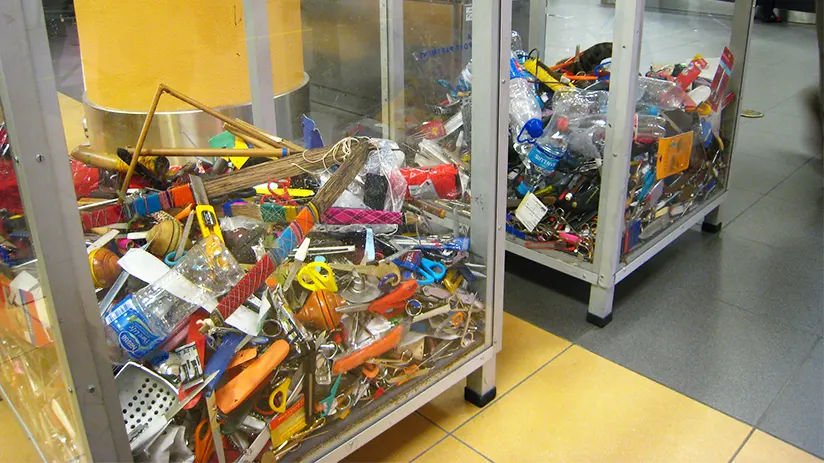
The Jorge Chavez has one of the most advanced baggage screening systems in all of America. The administration implemented this screening system on both international and national flights. In this sense, know very well the things prohibited and accepted on board will be recommendable. Thus avoiding any uncomfortable inconvenience.
- Carry-on Suitcase: Do not pack drugs, sharp objects, firearms, knives, gels, liquids, or aerosols over 100 ml.
- Checked luggage: The forbidden items in checked luggage are drugs, flammable products, knives, and sharp objects. This list does not mention firearms or Lithium-ion batteries. However, it does include electronic devices with lithium batteries, such as tablets, laptops, and e-cigarettes.
These are the most important forbidden objects to pay attention to in each type of luggage. However, you can see more specific information on Lima Airport Partners. We assure you that knowing the information will save you from embarrassing situations at the Airport.
Narcotics
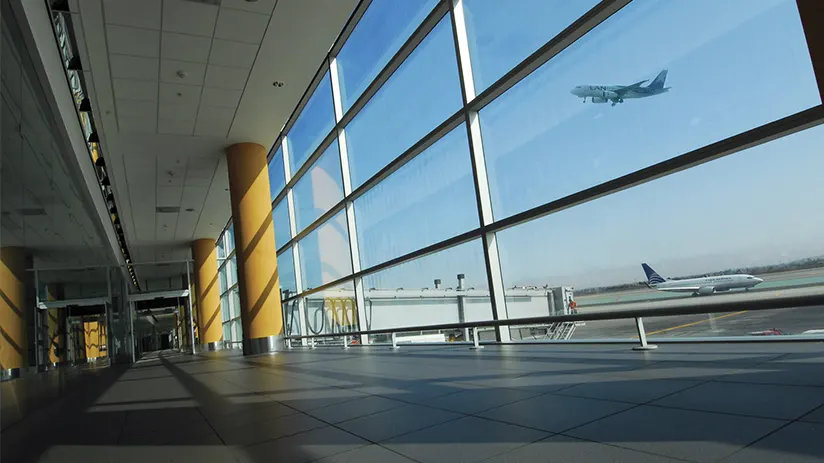
The airport of the Peruvian capital presents a high flow of travelers per day. Therefore, many specialist consider it a hub throughout South America.
Its modern baggage check system connect information with the Peruvian police station of the airport. They are specialist in illicit drug trafficking. In this sense, the police offer maximum control as far as drug trafficking.
Also, the team from the police Anti-Drug Directorate receives constant training. And they use the same surveillance processes as the US police. Furthermore, Peruvian sentences for illicit drug trafficking are among the most royal in the world. Therefore, if a Peruvian officer asks you to open your suitcase, do not raise any objection.
Separate note: Peru prohibits the entry of any type of Cocaine Base Paste and any chemical derivative of Coca. Peru permits the use of Coca directly as Coca mate or chew Coca leaves. However, other countries don’t allow this practice.
Therefore, if you are going to bring coca leaves from Peru, be careful! You may have problems arriving at the airport.
International Connection
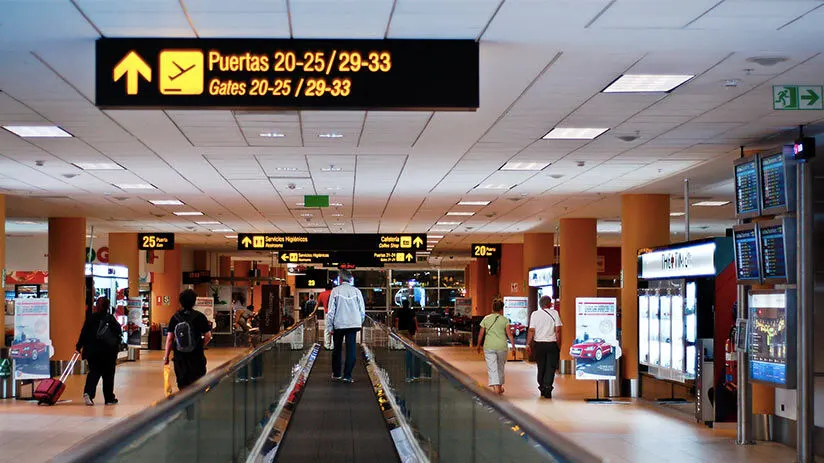
When you arrive at the airport, go directly to the next departure lounge without passing customs control. From this point, the procedure is similar to taking an international flight.
On the other hand, you can go outside the airport to visit the Lima center. However, assure yourself that you will have enough time to stay back on time for your next flight. The traffic is really chaotic. There is no subway, and you can lose valuable time getting outside the airport.
Besides, you’ll have to pay a right of re-entry fee to the country’s customs office, which is $31.
National Connection
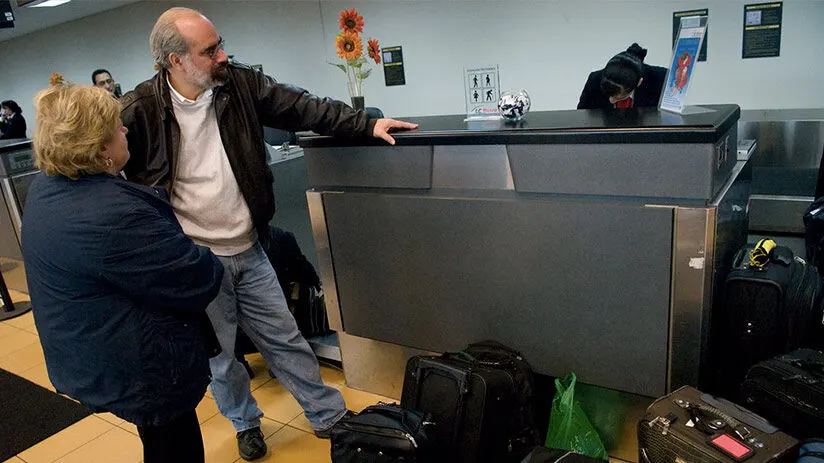
If you have a domestic connection, be sure to pick up your luggage. After going to the airline counter, pick up your boarding pass and check your luggage back into your new flight. Don’t think that the airline is responsible for moving your bags from one flight to another.
Airport FAQs
A. Can you sleep at airport of Lima?
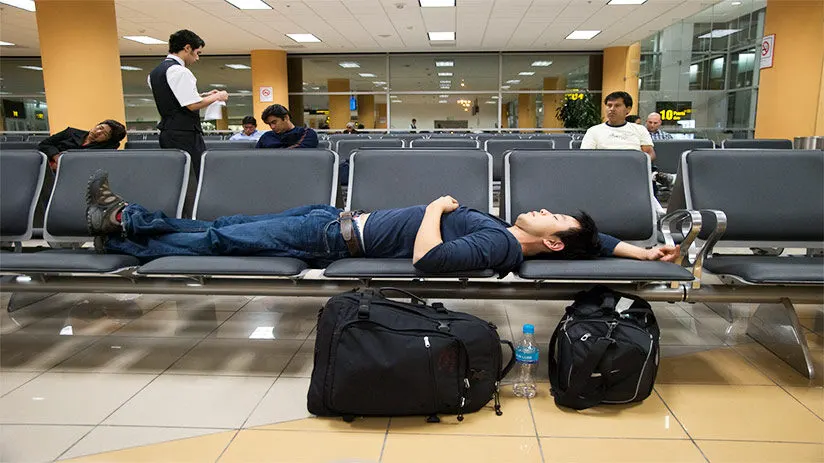
You can spend the night in the food court on the terminal’s second floor. Or in the Starbucks on one side of the food court. There, you can take advantage of the Wi-Fi.
You can even take a nap in the national and international flight departure rooms. There, the seats have no armrests, and one can stretch out on three or four of them.
B. Surrounding hotels
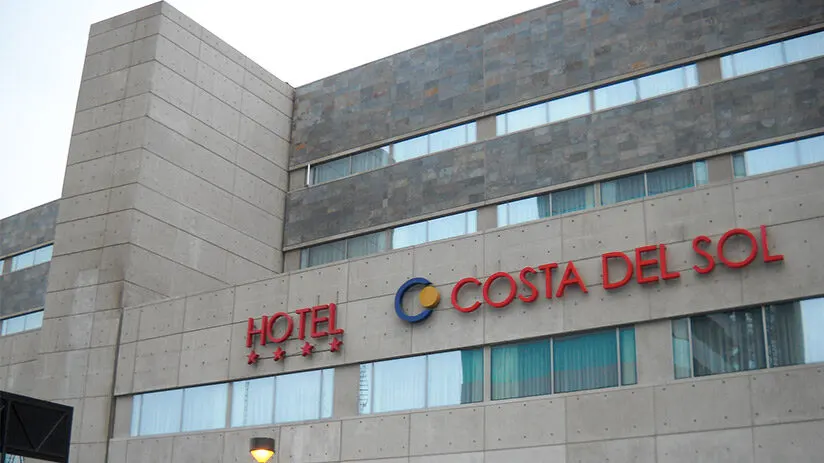
1. Costa del Sol Hotel Wyndham Lima airport
Four-star hotel located in front of the terminal (inside the airport complex). The hotel offers rooms from $140 to $160, even though it has diurnal rooms from 10 am to 6 pm. The hotel offers a spa, restaurant, breakfast service, and business center. A corridor on the second floor connects it with the airport terminal.
2. Holiday Inn
A three-star hotel located in front of the airport complex (Only divided by a busy oval). It offers transportation in and out of the airport as a courtesy. It also has a restaurant, gym, covered pool, and large rooms, among other things. If you are on family holidays in Peru, this hotel is perfect for you!
3. Las Fresas Hostel
For economy budgets, there is the Las Fresas hostel. It is a hostel 5 minutes from the airport. It also has private and shared rooms, without breakfast service or transport to the airport, so please take note.
C. Travel with pets
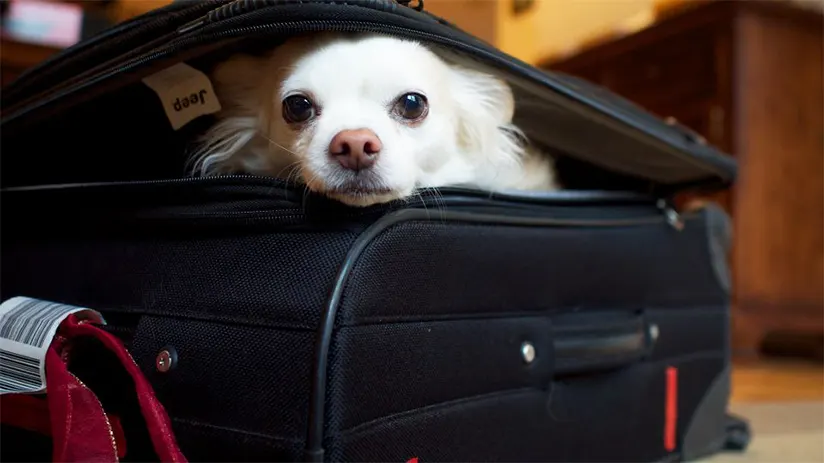
Peru only considers considered pets to be cats and dogs. Other animals like birds, rodents, rabbits, fish, and reptiles need an export health certificate from the country of origin. In addition to the need for a special import permit from Peruvian SENASA.
Also, Peru doesn’t require microchips for pets or proof of rabies title, or a special import permit for dogs and cats. Except for kittens of 12 weeks of age and without vaccination. In addition, the country has no prohibited breeds, according to SENASA.
By the way, SENASA means National Agrarian Health Service. And it is the government institution responsible for allowing the entry of foreign pets.
Today, there are three forms of traveling with pets. The first one is to accompany yourself in the same flight cabin by occupying a seat. The second way is as a hand luggage, being close to your feet. The third form is like air cargo.
In this last situation, a responsible air company vet will sedate the pet. And he will travel on the luggage storage.
If you are traveling with pets in the airplane cabin or checked luggage, it is easy to leave the airport. But not so when you take your pets as air cargo. In all cases, there are 3 important documents to show to SENASA upon your arrival at Jorge Chavez airport.
1. Documents
- At least 14 days after your arrival in Peru, you need to have a document from a vet in your home country. This document should state that your pet is healthy.
- Vaccination certificate for dogs against Parvovirus, Distemper, Hepatitis, and Leptospirosis. In the case of cats, the vaccination certificates must be for Calicivirus, Rhinotracheitis, Feline Viral, and Panleukopenia (FVRCP)
- Recent proof of veterinary treatment against external and internal parasites.
2. Process of arrival
- Whether your pet travels in a flight cabin or as accompanied luggage, you will have to get off the plane with them. And after, picking up your bags. Or, if you have a pet traveling as air cargo, you can pick them up from the baggage reclaim lane. Immediately after, you will have to head to the SENASA area to check on your pet.
- The SENASA official vet reviews your documents and checks the pet. You will have to pay a tax for the pet examination, around $27. And another tax for the pet’s permit to enter the country, around $9.
- Finally, the official vet can accept the entry of the animal to Peru or reject it. In the latter case, the veterinarian can perform new tests, impose a treatment, and quarantine the animal. Or, in the worst case, return it to its country of origin.
3. Leave Peru with pets
You will have to inform yourself months in advance about the requirements for pets entering the destination country. These requirements can include microchips for pets, vaccinations, and health certificates.
Or, even negative rabies titer test results issued by an official serology laboratory. In Peru, unfortunately, there are not them. Therefore, you will should send these rabies samples to Chile, but the certificates may take time to return.
Thus, the best way to inform yourself about the requirements of pet entering is through the same airline company.
In any case, SENASA requires the payment of tax for the right of revision, which is around $36. And the following documents allow the departure of any pet from Peruvian soil:
- Certificate of Good Health issued by a veterinarian affiliated with the Veterinary College of Peru.
- Current rabies vaccination certificate issued by a veterinarian affiliated with the Peruvian Veterinary College.
- Recent proof of veterinary treatment against internal and external parasites.
- If you want to travel with a Peruvian Hairless Dog, you need to get an export permit. The National Committee for their Protection emits this permission.
To travel with your pet, arrive at the airport 4 hours before your flight. You will need to go to the SENASA area, show your documents, and have your pet checked by a SENASA vet.
D. Important data
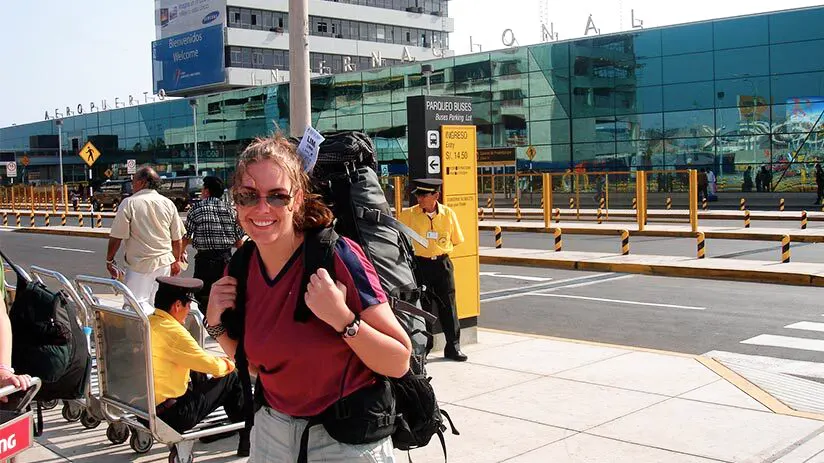
- Most frequent airport hours: Generally the busiest times you will see people at the airport in the morning are between 8 and 10 AM. While in the afternoon it is from 7 PM to 12 AM.
- A large majority of international flights to Lima depart and arrive late at night. So this is usually the busiest time at passport control. And can you sleep at the airport? You can’t, but there are a lot of luxury hotels to take advantage of.
- Security: Another thing to keep in mind is security. Peru is safe to travel to, as is its main airport. But is airport of Lima safe at night? Yes, it is.
- However, we highly recommend avoiding the non-touristy areas in the surrounding areas. If you take a taxi, be sure to do so with a registered company.
“AIRPORTS WILL ALWAYS REMIND ME OF WHAT IT MEANS TO LOVE”
As you will see, knowing the Lima Airport is essential when organizing your trip. From making your check-outs to knowing the luggage storage. We hope, together with the Machu Travel Peru team, to have been helpful.
If you want to know more about everything the airport has to offer, you can consult with our advisors. They will be able to help you through this site. As well as how to help you book your tickets in advance.
Our team will be waiting for your soon visit to our magical country. What are you waiting for to organize your trip right now?